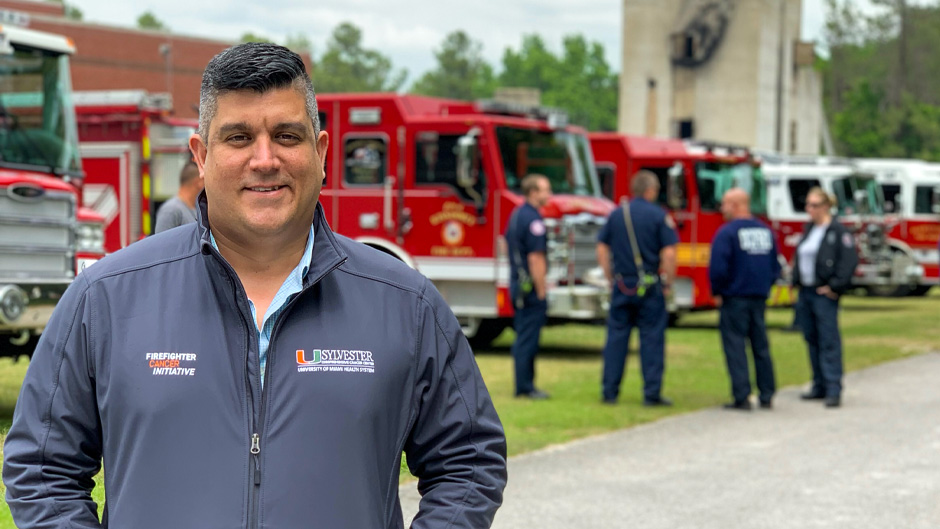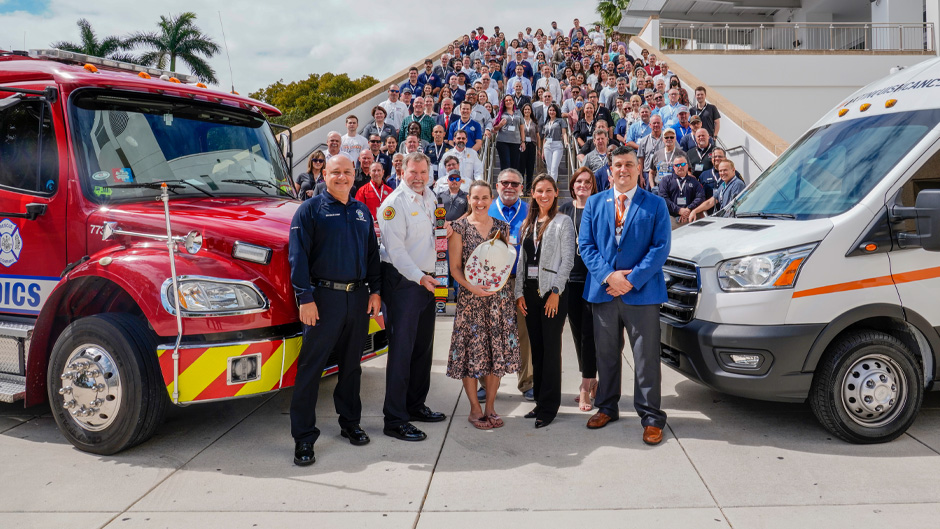There’s no question that becoming a firefighter is a dangerous job.
But beyond the obvious perils of saving lives, research reveals that the profession also brings other risks with it. Chief among them: cancer.
It’s that discovery that led to the creation of Sylvester Comprehensive Cancer Center’s Firefighter Cancer Initiative (FCI) in 2015. Now, the ominous trend has gripped the attention of global health researchers.
Alberto Caban-Martinez, deputy director of the FCI and associate professor of public health sciences at the University of Miami Miller School of Medicine, was one of 25 scientists to join a panel of the International Agency for Research on Cancer (IARC), the specialized cancer division of the World Health Organization, that recently decided to re-classify firefighting as a carcinogenic line of work. The new IARC designation, Group 1, means that the firefighting profession is carcinogenic to humans, whereas previous classifications only deemed it possible that firefighters may get cancer.
“This is also another stake in the road that shows firefighters are exposed to carcinogens and being in this profession is carcinogenic,” said Caban-Martinez, an occupational epidemiologist.

Published recently in the medical journal The Lancet, the findings indicate that this hazardous link exists because as part of their daily profession, firefighters encounter a range of toxins known to cause cancer. They also concluded that there is sufficient evidence for bladder cancer and mesothelioma in firefighters globally, while there is also limited evidence for colon, prostate, and testicular cancers, as well as skin cancer (melanoma) and non-Hodgkin lymphoma.
Now that the profession is deemed carcinogenic, it could pave the way for more regulations and funding to protect firefighters, as well as for those who are already battling cancer, Caban-Martinez said.
Erin Kobetz, who directs the FCI and serves as associate director of population sciences and cancer disparity at Sylvester, said it was a critical step for the global community to recognize the dangers that firefighters endure.
“Evidence undisputedly indicates that firefighting is associated with increased cancer risk, and this finding ensures the first responders will not have to lobby for disability and other benefits associated with a cancer diagnosis,” said Kobetz, who is also the University’s vice provost of research and scholarship and a professor of public health sciences.
According to a 2013 study from the National Institute for Occupational Safety and Health, firefighters are 9 percent more likely to face a cancer diagnosis and are 14 percent more likely than the average person to endure a cancer-related death.
The decision to reclassify came after the scientific team spent months reviewing studies from across the globe published since 2010 on cancer and firefighters, Caban-Martinez pointed out. A full IARC monograph explaining their reasoning will be published in 2023.
However, Caban-Martinez noted that the new designation demonstrates the hard work and research of the FCI throughout the past seven years.
“This work shows the international impact of our research on cancer control and prevention in the firefighter workforce,” he said.
The FCI was conceived around 2014, when the Miami-Dade Fire Department brought several years’ worth of health records to researchers at Sylvester, demonstrating that too many of their firefighters were falling victim to the disease. Researchers like Kobetz and Caban-Martinez began investigating at fire departments across South Florida and quickly learned that cancer in the fire service was not limited to those who combed through the wreckage of the Sept. 11 attacks. In 2015, the state of Florida appropriated funding to formalize the FCI.
Since then, a team of close to 30 researchers at Sylvester have investigated the types of cancers afflicting firefighters in South Florida. Many have worked to create new trainings to protect those on the front lines from harmful toxins, by encouraging them to wear protective respirators and to clean themselves and their gear after visiting a disaster scene.
The FCI also created a green bucket intervention, that includes dish soap, scrub brushes, and wipes for firefighters to wash off their gear before leaving a scene, and the group distributed them to more than 4,000 trucks across the State of Florida. Last year, more state and Salah Foundation funding allowed the FCI to build a mobile clinic that does physical exams of firefighters in Miami-Dade County and to provide cancer screenings. The FCI is hoping to expand the program.
Two years ago, Caban-Martinez, Kobetz, and David Lee, Chair of the Miller School of Medicine Department of Public Health Sciences, published a study about the links between cancer and firefighters in Florida. From 1984 to 2014, they learned that male firefighters were at a 66 percent greater risk than the general Florida population to get testicular cancer, they were at a 55 percent increased risk to contract skin cancer, and a 36 percent increased risk to get prostate cancer. They were also twice as likely to suffer from thyroid cancer, and at a 19 percent increased risk to come down with late-stage colon cancer. In addition, female firefighters—which represent about a tenth of the service—are 2.5 times more likely to suffer from brain tumors, and 2.4 times more likely to get thyroid cancer. They are also at increased risk for melanoma.
“We are also seeing firefighters getting cancer at earlier ages than the general population and that’s probably because of their exposure at work to carcinogenic compounds,” Caban-Martinez said.
Among other things, he said that he believes the new reclassification will also help researchers further investigate the different cancers that firefighters endure around the world and will hopefully offer new solutions to protect them.
“Because so many other cancers were identified and listed in this IARC monograph, it will also inspire more research to identify the gaps, so that those cancers will be addressed more,” Caban-Martinez said.

